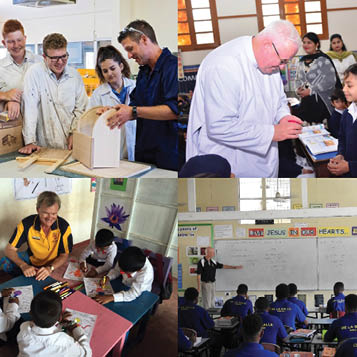The Lasallian Teacher: Skill-Set, Relationship, Motivation
What defines a great teacher? How does a Lasallian teacher “touch hearts”? Is the “Twelve Virtues of a Good Teacher” written 240 years ago in France any clue? These are apposite questions when the current calls for better-skilled teachers and less cramming in curricula are commonplace. This ferment is accompanied with a perceived lower status for the profession (at least in Australia).
Context: Training Teachers – De La Salle’s Experience and Innovations
Seventy years after the Founder’s death, the cataclysmic French Revolution of 1789 approached, with the resultant dissolution of the Institute. The Brothers had 121 communities, and were teaching about 36,000 pupils in 550 classes. Brother Agathon, elected Superior General in 1777, was anxious to foster the heritage of the Founder, and had been planning to write an updated version of “La Conduite des Ecoles” (The Conduct of Schools), De La Salle’s premier educational text. When published in 1720, it had been the result of “a great number of conferences” with principal Brothers - experienced teachers over 25 years and hence a fertile ground for young Brothers learning their trade.
This “Conduct of Schools” document (of which the Generalate Archives holds the manuscript) was a key source for Agathon who authored a Circular Letter to the 850-900 Brothers of the Institute, entitled “The Twelve Virtues of a Good Teacher”. These “virtues” were listed at the end of the Conduct. What resulted, in his busy leadership years was an original treatise, which Br. W. J. Battersby’s history says was a new “work… a little masterpiece of its kind, and was widely read and appreciated”, by the Brothers and beyond.
“Virtues” for a Teacher – Ancient History?
Great philosophers of the past – eastern and western- extolled “virtue” as an important quality for a citizen and an aspiration for moral civilized societies; it was not solely the preserve of Christianity. Teaching, always essential in Christian practice, produced educated elites in clergy and the nobility over the centuries, but universal “free, secular” schools were the creation of modern cultures. (Religious orders, female and male, came into the field in the 16th century onwards, and the “Brothers of the Christian Schools” were quite revolutionary in what they offered – solid literacy, numeracy and Christian teaching, as well as other vocational subjects – in free, group instruction, and in the vernacular - to the mass of very poor boys in French cities, from 1680.
One source for the Conduct, and hence the 12 Virtues, stressed the growth of the teacher’s personal habits – from conscious willed actions – as critical in forming virtue in the unrewarding work of 17th century teaching. Modern psychology might cast doubt on such in producing a fine teacher.
But the status of teaching and the need for training was critical at the time:
“We see today (1687), unfortunately, the holy and exalted teaching vocation given over to anyone who comes along, just because he happens to be able to read and write. Although these teachers are often in poor health and in bad straits and perhaps addicted to vice as well, we do not hesitate to hand over to them the care of our young people. We don’t seem to realise that by doing something to help these wretches, we are doing real harm to the public at large…No wonder that this occupation is so despised when it is so often undertaken by people who are miserable, unknown and of no quality whatsoever”.
Charles Demia, priest, acquaintance of Nicholas Roland, founder of several “Little Schools” in Lyon 1660’s
(Of course, there was the strong powerful Corporation of the “Writing Masters”). How do modern candidates for teaching compare?!
John Baptist echoed Demia’s assessment with his first-hand experience of his initial untrained “school masters” of 1680. His “pure charity” in starting the work and living with them was, if not repugnant, at least “impossible to bear”: they were “lower in status than my valet”.
What strikes you in Agathon’s work on Virtues is the constant theme of the teacher’s outward behaviour, his strong positive relationship with the student and the link with more interior, spiritual qualities. These are part of his skill-set. The teacher-
“announces in all his external appearance, a discretion & modesty which are the… fruit of the maturity of his spirit…but in a special way, he is concerned to maintain tranquillity by his balanced spirit”.
(Modesty meant more than quiet reserve or shyness; it meant civilized, polite self-confidence).
Much of what follows springs from Br. Gerard Rummery in his masterly analysis and appreciation of Agathon’s text).
“Twelve Virtues of a Good Teacher”
Br. Agathon, from his wide school experience, lists and explains 12 “virtues” or learned personal talents helpful for a successful Brother-teacher.
Seriousness, Silence, Humility
The externals of the teacher have impact -established good order, one’s pace of presentation, the dignity of actions, politeness (called by Agathon ‘Gravity’).
One is encouraged to “remain silent when he/she should not speak, and speak when one should not be silent.”
“Humility” is interpreted as “to judge ourselves at one’s true worth”, not a fawning or pretense.
Prudence, Wisdom, Patience, Discretion
The skills here are to use moderation, foresight, self-restraint and practical common sense in practice and thinking. One gives due weight and measure to techniques, interactions- a cultivated person would.
Gentleness (Kindness / Tenderness)
Br. Gerard points out that remarkable in the treatment of the Virtues is that the author gives 58 pages of 159 pages in the original to “Gentleness”, this in an era when corporal punishment was so prevalent in schools. Agathon appeals to love and praise: the master must develop for students the feelings of a father (or mother). An educational maxim, he says, is that “love is won by love”. Lasallians have no problem in distilling this Virtue into the Founder’s catchphrase of “Touching Hearts”. De La Salle’s Rule (1718) 7.13 said: “The Brothers will tenderly love their pupils”. (Love was broad - interest, devotedness, commitment to service, not understood as purely sentimental and affective) (Lauraire 183.)
The Virtues text condemns those teachers who :
· sin by their hardness
· command what is beyond the attainment of their pupils
· punish with an excess of severity
· command with haughtiness
· do not distinguish the seriousness of faults
· fail to listen to the excuses of the pupils and always refuse to pardon, even faults due to lightness or forgetfulness.
The Conduct forbade beating pupils, or slapping them. There is, Br. Gerard says, “the deeply Christian aspect of reverence for each pupil”.
Zeal, Watchfulness, Devotion, Generosity
The last four Virtues point to the totality of the teacher’s commitment, especially in zeal, devotion and generosity, for Lasallians who look on the work as “God’s work” – the Founder’s phrase. That person views , believes that teaching is not purely a career, but a Christian ministry or service in some form.
The Teacher-Learner Relationship: Mutual Respect
In the history of pedagogy, the impact of Jean-Henry Pestolozzi (1746-1827), the great Swiss educationalist, was significant in moving the emphasis toward the youthful learner. Today, understanding and respecting the child as central is prominent in education, youth welfare, and youth counselling (cf. the U.N. ‘Rights of the Child’). For Br. Agathon, the Management was central, and from it flowed, in his discussion of the Virtues, the obvious strong interaction of the teacher and pupil relationship in progressing growth of both in their inner selves.
Other sources were De La Salle’s Meditations and the Rules of Christian Decorum and Civility. The apprentice Brother or teacher’s learning about social decorum, politeness and commitment helped one’s sense of self-worth to grow.
Teachers’ character and their values are presented to the pupil, as a role model. The results were to be benefits for the child’s personal development, future work and integration in society. The very deep love, understanding and respect for the learner shines through the training treatise, points out Br. Gerard.
The balance and wisdom of the 12 Virtues comes through in the description of the growth of the virtues in the pupil’s interaction with the teacher:
· “Pupils would not listen to what a teacher whom they did not esteem might teach them”;
· (The teacher) “suffer their (students) natural defects, their coarseness, their inefficiency…their disobedience, ingratitude, resistance… (nevertheless he does not forget…to repress everything that might weaken his authority and lead to) unruliness, insolence, lack of application”;
· “Children of a shy, submissive spirit who admit their faults should not be punished as those who are unruly, perverse, tough, who deny their faults”.
Throughout, the individuality of the student is respected and worked with; the Lasallian ethos included seeing youth as noble baptized children of God . One commentator suggests that Agathon had “a perfect knowledge of a child’s heart”.
Authority, Correction & Child Safety
The study of Gentleness provides the opportunity to define authority: “the ascendancy which inspires respect and submission”. The means of establishing it are spelt out, and it leads to the topic of correction of students, which, Agathon claims, must be voluntary, respectful and silent. (The pupil should be drawn to accept and understand the reasons for it; he /she respects the punishment).
In the modern climate of needful regulation of child safety, Agathon says: “They shall love all their students tenderly. They shall not, however, be familiar with any, nor give them anything through particular friendship but only as a reward” (quoting the Brothers’ Rule & Foundational Documents). The teacher (will not) “ever be alone in any place with a pupil, unless he is in a position where he can be seen by someone.”
Throughout, the treatise is, in Br. Gerard’s words, “down to earth, full of common sense, realistic in its evaluation of what happens in classrooms...(it) centres …on the concept of gentleness…’touching hearts’.”
Lasallian Formation Today
· How important, or not, are these characteristics / qualities for today’s teacher ?
· Are there more modern words or concepts for such?
· What of spontaneity / freedom of expression / imagination in behaviour and learning?
· What other qualities are needed in today’s educative climate?
References:
Battersby, W J : The History of the Institute (FSC) in the Eighteenth Century 1719-1798 (1960).
Lauraire, Leon: The Conduct of Schools: Pedagogical Approach (Cahiers Lasallians 62) (2006).
Morales, Alfredo: ‘The Teacher-Pupil Relationship’, 61, in Lasallian Themes 2 (1995).
Rummery, Gerard: Twelve Virtues of a Good Master (2006) [unpublished manuscript].
(Author: Br Gary Wilson)
- Log in to post comments

